Stéphane Del Pino is a Research Engineer and holds an HDR in Applied Mathematics. He is currently member of an R&D team at CEA whose objective is to develop new models and new numerical methods for HPC numerical simulation codes.
His main research topics are on the one hand finite-volume methods and more specifically their application to the approximation of gas dynamics in Lagrangian coordinates; and in the other hand mesh adaptation methods.
PhDs co-supervised
-
A. DROUARD, Méthode numérique semi-implicite pour le modèle de l’hyper élasticité, Thèse de doctorat Sorbonne Paris Saclay / CEA, en cours.
-
A. PLESSIER, Schémas implicites semi-Lagrangiens pour la dynamique des gaz compressibles, Thèse de doctorat Sorbonne Université / CEA, 2023.
-
D. YAKOUBI, Analyse et mise en oeuvre de nouveaux algorithmes en méthodes spectrales, Thèse de doctorat CEA/Univ. Pierre et Marie Curie, Paris 6, 2007.
International Journal for Numerical Methods in Engineering, Volume126, e70051, 2025

abstract
Abstract
In this article, we propose and investigate an explicit partitioned method for solving shock dynamics in fluid–structure interaction (FSI) problems. The method is fully conservative, ensuring the local conservation of mass, momentum, and energy, which is crucial for accurately capturing strong shock interactions. Using an updated-Lagrangian finite-volume approach, the method integrates a subcycling strategy to decouple time steps between the fluid and structure, significantly enhancing computational efficiency. Numerical experiments confirm the accuracy and stability of the method, demonstrating that it retains the key properties of monolithic solvers while reducing computational costs. Extensive validation across 1D and 3D FSI problems shows the method's capability for large-scale, fast transient simulations, making it a promising solution for high-performance applications.
Computers & Fluids, Volume 297, 106648, 2025

abstract
Abstract
In this paper, we present an extension to non-uniform meshes of a 1D scheme [Rémi Abgrall and Davide Torlo. “Some preliminary results on a high order asymptotic preserving computationally explicit kinetic scheme”. In: Abgrall and Torlo (2022). This scheme is arbitrary high order convergent in space and time for any hyperbolic system of conservation laws. It is based on a Finite Difference technique. We show that this numerical method is not conservative but it satisfies a Lax–Wendroff theorem under restrictive conditions on the mesh. To relax this condition we propose a Finite Volume alternative. This new discretization can be seen as a direct generalization to non-uniform meshes of the Finite Difference schemes in the sense that the fluxes of both methods are the same on uniform meshes. We apply the two schemes to the Euler system and we assess their performances on regarding test problems of the literature.
Journal of Computational Physics, Volume 478, 1 April 2023, 2023

abstract
Abstract
In this paper, we propose an adaptive mesh refinement method for 2D multi-material compressible non-viscous flows in semi-Lagrangian coordinates. The mesh adaptation procedure is local and relies on a discrete metric field evaluation. The remapping method is second-order accurate and we prove its stability. We propose a multi-material treatment using two ingredients: the local remeshing is performed in a way that reduces as much as possible the creation of mixed cells and an interface reconstruction method that can be used to avoid the diffusion of the material interfaces. The obtained method is almost Lagrangian and can be implemented in a parallel framework. We provide some numerical tests which attest the validity of the method and its robustness.
ESAIM M2AN Volume 57, Number 2, March-April 2023, 2023

abstract
Abstract
We construct an original framework based on convex analysis to prove the existence and uniqueness of a solution to a class of implicit numerical schemes. We propose an application of this general framework in the case of a new non linear implicit scheme for the 1D Lagrangian gas dynamics equations. We provide numerical illustrations that corroborate our proof of unconditional stability for this non linear implicit scheme.








